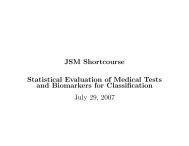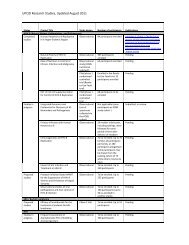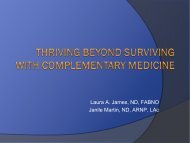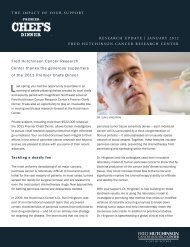Summer Undergraduate Research Program - Fred Hutchinson ...
Summer Undergraduate Research Program - Fred Hutchinson ...
Summer Undergraduate Research Program - Fred Hutchinson ...
Create successful ePaper yourself
Turn your PDF publications into a flip-book with our unique Google optimized e-Paper software.
Graduate School Personal Statement #5<br />
Graduate School Personal Statement Example #5<br />
The average human adult has approximately ten billion cortical pyramidal neurons. I have one<br />
extra: the tattooed soma rests in the hollow of my back, stretching spiny dendrites out towards<br />
my hips, and a single axon reaches up my spine, its collaterals curving up my neck and over my<br />
shoulders. The black-‐‑inked composition is reminiscent of the intricate drawings of Santiago<br />
Ramón y Cajal, one of the fathers of neuroscience. The tattoo is symbolic of my dedication to<br />
investigating the many exciting questions neuroscience has to offer, but I was not always sure<br />
enough of my career choice to etch it on my skin.<br />
My childhood was spent trying on many hats and each birthday brought a new goal: first artist,<br />
then veterinarian, then astronaut, writer, theatrical lighting designer, and finally “I don’t<br />
know.” It wasn’t until I had the opportunity to participate in biological research that a lasting<br />
preference began to emerge in my mind. I spent my final high school semester investigating<br />
single neucleotide polymorphism (SNP) frequencies in lettuce cultivars at the XX XX Genome<br />
Center. I was immediately hooked; I loved the process of scientific problem solving as well as<br />
the idea that I could uncover a previously hidden corner of the universe.<br />
After several summers working in agricultural biology research labs, I enrolled in an<br />
introductory neuroscience class taught by Dr. XX XXX at XXX State University. I was utterly<br />
fascinated by this field and I quickly asked to join the XX lab, which uses zebrafish as a model to<br />
study the hormonal glucocorticoid system. My research partner and I found that a mutant with<br />
defective glucocorticoid receptors displayed decreased spontaneous swimming activity<br />
combined with increased stress responses. In addition, the phenotype could be rescued with the<br />
anti-‐‑depressant Prozac, suggesting that the glucocorticoid system may play an important role in<br />
modulating behavioral stress disorders. I presented preliminary findings at the XX XX (XXX)<br />
meeting in 20XX, which gave me a tantalizing taste of what it is like to participate in the greater<br />
scientific community.<br />
It was only after immersing myself in research for a year that I knew I had found my place.<br />
Dissecting behaviors down to the molecular and cellular components of neural networks<br />
thrilled my analytical brain. I sensed I had only just scratched the surface, and that was not<br />
enough-‐‑-‐‑I wanted to understand how all of the pieces interact to give rise to a functioning<br />
nervous system. Once I came to that realization, the neuron tattoo seemed a natural display of<br />
my interest in the field, and now serves as a visual reminder of my intent to contribute to<br />
neuroscience research.<br />
To that end, I applied and was accepted to the XXXXX (XXXXX) XXXX (XXXX), where I worked<br />
in Dr. XX XXX’s lab, studying the formation of electrical synapses. I spent the summer<br />
characterizing a mutant line of zebrafish from a forward genetic screen looking for defects in<br />
synaptogenesis. I found that there seemed to be a loss of two key proteins at the site of the<br />
synapse, though the general neural circuitry remained intact, suggesting that the mutation was<br />
in a gene critical for electrical synapse formation. Throughout this investigation I retained a<br />
sense of excitement every time I turned on the microscope to look at my results; watching<br />
individual neurons glowing against the dark background of their unstained neighbors still<br />
gives me pause. In addition to studying these mutants at the level of individual synapses, my<br />
32
















